By Nancy F., Cornwall Master Gardener
This article appeared in the May 2019 Issue of Gardening in Orange County. Click here to subscribe!
The Alpine Garden
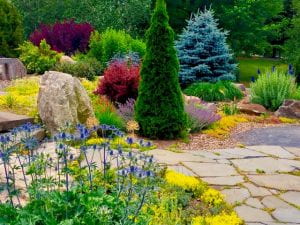
Explore the Alpine Garden and its varieties of succulents, spruces, perennials and grasses, surrounded by rock formations and waterways. If you take time to look around at all the different colors and textures, you will notice a very delicate plant known as the crown anemone or Spanish marigold (Anemone coronaria).

The crown anemone’s dark-centered flowers can be found in an array of colors from purple-blue, red, pink or white. They are a perfect addition to rock gardens, flower bed, and containers. They do well in full sun, but will tolerate light shade in very hot areas. Soil preference is sandy loam. Crown anemones are propagated by underground storage structures called corms, which are similar to a bulbs and tubers. Corms can be planted after the danger of frost, which is usually early May here in Orange County New York. For continuous bloom throughout the summer, they should be planted every two or three weeks. (Note: The small corms should be soaked for several hours before planting). For those people who garden in containers, you can create a stunning display by combining crown anemones with tulips and grape hyacinths.
The Asian Maple Garden
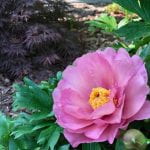
One of the numerous attractions in the Asian Maple Garden is the intersectional Itoh Peony ‘Morning Lilac’. This stunning flower was created by crossing a tree peony with the more common herbaceous peony. Intersectional peonies have strong, short woody stems and large flowers like a tree peony, but die down to the ground in winter like an herbaceous peony. These plants prefers a neutral to alkaline soil pH, and need good drainage. Autumn is the best time for planting peonies.
The Nellie Mazur Perennial Garden

The Nellie Mazur Perennial Garden is a lovely mix of shrubs and herbaceous perennials. Recently added is to this garden is a magnificent piece of Agrisculpture made by collaging (welding) found vintage and antique metal with new steel to create an entirely new form. The piece is entitled “REMEMBER Agrisculpture: Seed Plates – Lovingly Rethought” is a 40 square-foot steel piece made from antique seed planter plates and gears. It was commissioned by the arboretum to honor the late Farmer Mazur and his passion for seed distribution.
The Remembrance Walkway and Garden
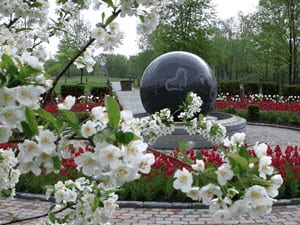
The Remembrance Walkway and Garden “honor[s] those who lost their lives and those whose lives have been altered by the tragic events of the September 11 attack on America”. The September 11th Memorial features a stunning rotating granite sculpture of the earth surrounded by bronze plaques with the names of the 44 Orange County residents who perished that day. A ceremony is held every year on September 11 to honor those that we lost.
The Raised Garden Beds
The Raised Garden Beds developed in 2002 are situated throughout the Arboretum and are home to a spectacular seasonal display of annual and perennial companion plantings. Every year visitors anticipate the arrival of the colorful spring display of numerous tulip varieties found throughout the grounds. The plants for the raised beds are grown in the arboretum’s Kosuga Greenhouse. This greenhouse houses 28,000 plants which includes plants for the raised beds as well as plants for the Arboretum’s annual plant sale. The purchase of new plants is made possible through the generosity of the Friends of the Arboretum and the patrons of the arboretum’s annual events.
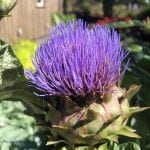
Two of the plants that are highlighted in the raised garden bed for their uniqueness are cardoon and cotton. Cardoon (Cynara cardunculus), also known as the artichoke thistle or globe artichoke, is an herbaceous perennial in the aster family and is hardy in zones 7-10. Unfortunately, Orange County New York is found in zones 5 and 6, so here it usually can only be grown as an annual. This plant requires full sun in a sheltered location with fertile, well-drained soil. The plant reaches 5 feet tall and 4 feet wide and is an architectural splendor. Its large, thistle-like flowers are quite ornamental. The violet-purple flowers are produced in a heavily spined capitulum (head). Choose companion plants that contrast with the blue to silver color of the foliage such as annuals with blue, purple or burgundy flowers.
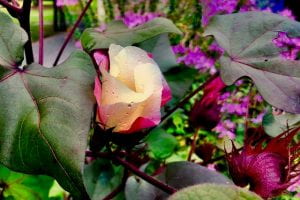
The second plant highlighted in the raised garden beds is the cotton plant (Gossypium hirsutum). The hibisicus-like bloom is initially white in color and later turns pink. The flowers stay on the plant for a few weeks, before they wither and fall leaving behind seedpods known as bolls. Fibers inside the boll continue to develop until the boll bursts open exposing white fluffy cotton. This annual grows three to five feet tall and prefers full sun and moist soil.
The Rill
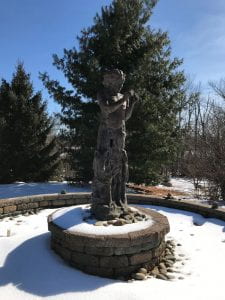
During the warmer months, a bronze statue of Pan, the god of woods, fields and flocks is surrounded by running water. The Rill was a developed by John and Connie Vanderberg in 2005 and the Pan sculpture was donated by Ruth Ottaway.
The Al Durland Memorial Pond
Surrounded by grass and woodlands, the Al Durland Memorial Pond, is a peaceful aquatic sanctuary. One can enjoy its beauty and serenity on the large deck that runs along one of its sides.
The Apiary
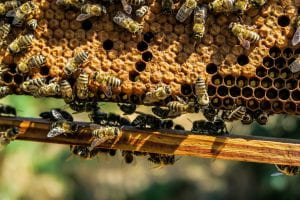
The Apiary is buzzing with bee activity this time of year. Our new beekeeper is starting classes for beginner beekeepers.
The Apiary is also a favorite site for the elementary school students visiting the arboretum with their classes to participate in the Garden Exploration with Master Garden (GEM) program. During the bee portion of this program, the students learn about the three different types of bees found within a hive – queen, worker and drone bees. They also learn all about honey production and the important role bees play in our environment. The arboretum sells its honey at their Holiday Boutique that is open from the end of November until the end of December.
The Veteran’s Garden

The Veteran’s Garden at the Arboretum is dedicated to our Veterans of the past, present and future and hosts a yearly ceremony to honor our Veterans.
The Ceremony Garden
The Ceremony Garden is a large open field surrounded by a beautiful rose garden, raised garden beds, and towering trees. This popular venue is available for rental through the Orange County Parks Department.
The Children’s Garden
The Children’s Garden was designed to get children outside and give them an opportunity to connect with nature. The Children’s Garden is both beautiful and educational. It hosts a myriad of children’s events throughout the year from backyard bird feeding to a its annual Fairy Festival.
For more information about the Orange County Arboretum and upcoming events check out their website: http://www.orangecountyarboretum.org/.
